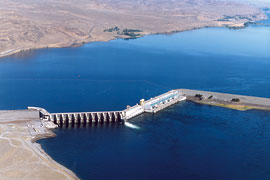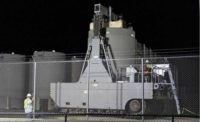 |
| SALMON SALAD? New FERC-approved turbine design at Columbia River dam in Washington state is set to boost survival rate for juvenile salmon. (Photo courtesy of Grant County Public Utility District) |
The Federal Energy Regulatory Commission is allowing a Washington state utility to replace one of 10 aging turbines at its 900-MW Wanapum Dam on the Columbia River with a specially designed unit to increase survival of millions of juvenile salmon that migrate annually through the hydro plant.
The so-called "Kaplan" turbine has been modified to minimize uncontrolled water turbulence, which has long been a primary cause of fish injury. The goal is to give the endangered salmon "a smooth ride," says Stephen Brown, director of natural resources for the Grant County Public Utility District.
The design tweaks elements of the entire hydraulic passageway, including the distributor, runner and draft tube, to reduce turbulence. New six-bladed runners and the distributors have minimum blade gaps, and wicket gate overhang has been eliminated.
The turbine has a spherical hub and corresponding modifications to stay vanes and wicket gates. The utility contends that while a 1% improvement in the short-term fish survival rate would be deemed a success, the re-designed turbine could boost that rate as high as 98%.
But fish biologists at the state Dept. of Fish and Wildlife are not buying the claim. "The odds that it will be highly beneficial for fish are pretty low, but it is likely to be at least neutral," says Rod Wooden, state policy coordinator for the Columbia River. He says the new turbine design will increase operational flexibility and power output during fish migration when flow rates and spills are defined by environmental rules.
The new turbine-generator output at 111.8 MW is an increase over the existing capacity of 103.8 MW because the system "minimizes hydraulic losses" that kill and injure fish, says Brian Nordland, a hydraulic engineer for the National Oceanic and Atmospheric Administration in Lacey, Wash., who was involved in the design of the new turbine. But he admits that the long-term survival rates of juvenile fish passing through the turbine remains unknown.
To significantly improve that outlook, all elements of the plant, not just turbines, must be addressed holistically, says Wooden. He says the state believes this could be accomplished at Wanapum Dam with construction of a separate engineered passageway through the powerhouse, which could cost $20 million.
|
Initial turbine replacement work at Wanapum Dam is set to finish later this year, with performance and biological testing next spring. If efficiency and survival goals are met, the utility intends to replace the nine other turbines in stages between 2006 and 2012.
The first test turbine is being manufactured by Voith-Siemens, York, Pa., at a cost of $18 million. The combined cost for all 10 turbines will be $143 million. The utility received a $2.4-million grant from the U.S. Dept. of Energy to complete original design work. Broomfield, Colo.-based MWH provided engineering support. The utility will install the turbines with support from Voith-Siemens, which will handle parts of the equipment to be embedded in concrete.
The advanced turbine design may be applicable at other sites in the Columbia River watershed where dams and power-generating equipment are largely responsible for major declines in migratory-fish populations. "Most of the Columbia River hydro projects use Kaplan turbines and a lot are aging," Brown points out. "This project will be watched closely."



Post a comment to this article
Report Abusive Comment